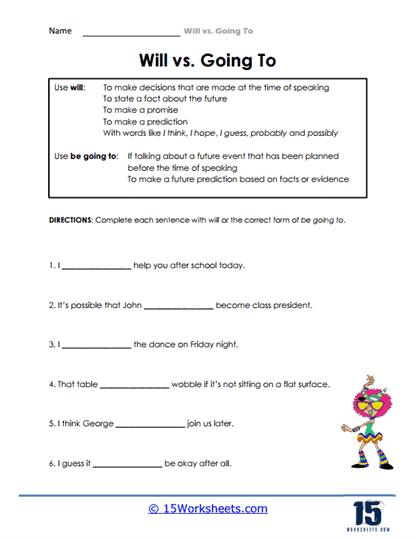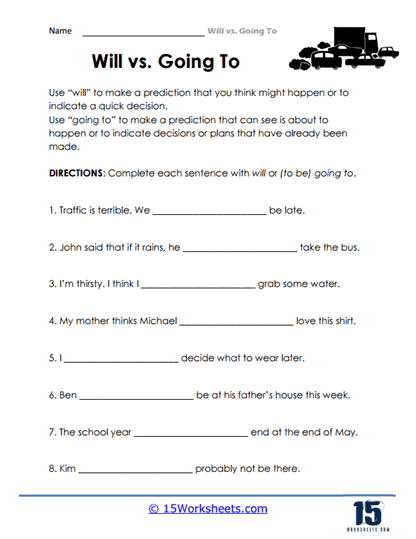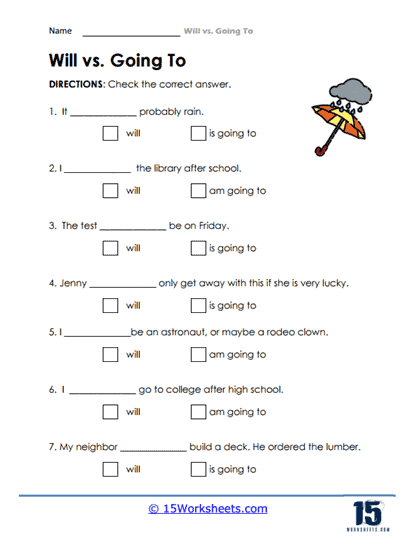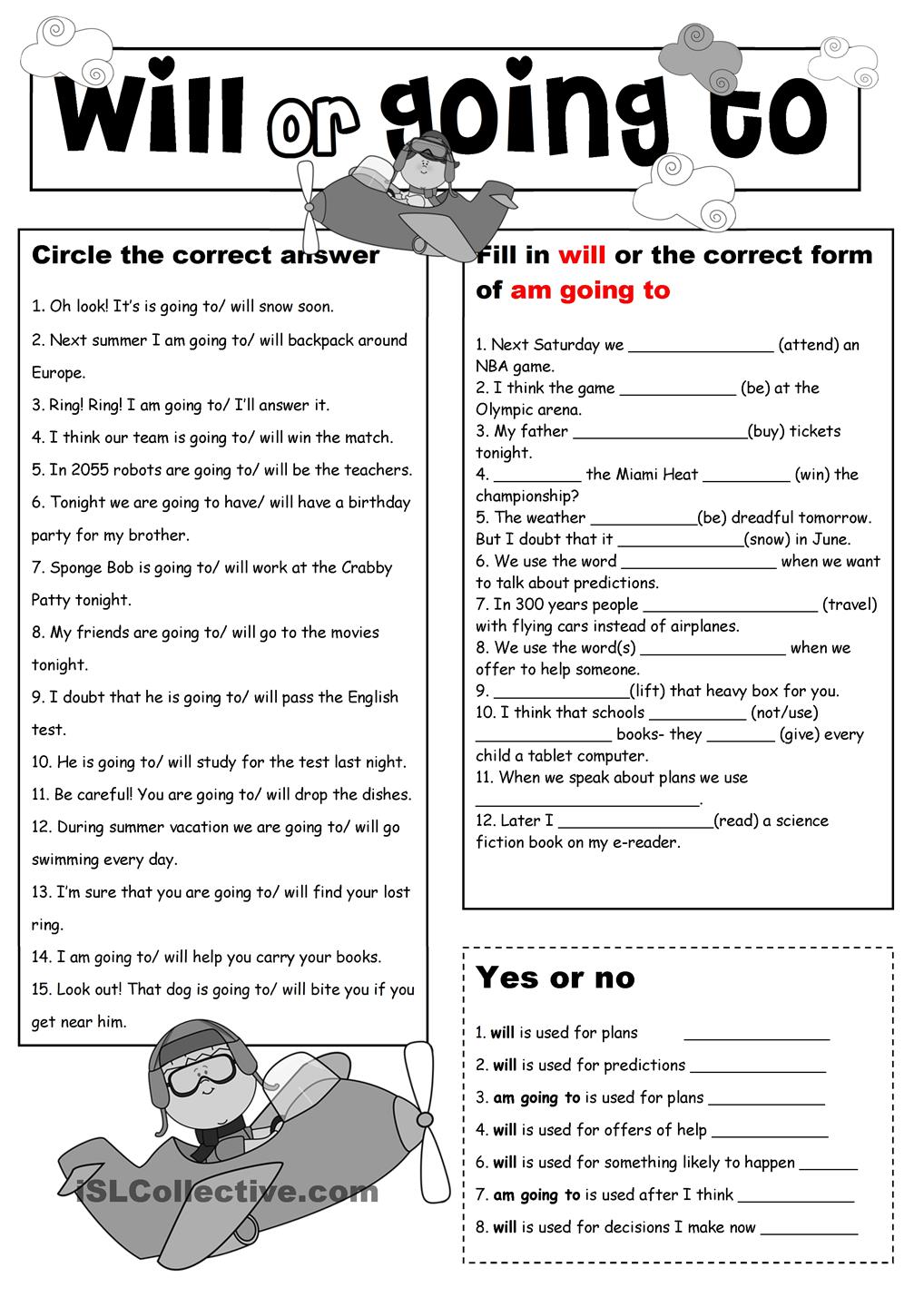
Mastering the Future: A Deep Dive into Future Tenses Worksheets – Will vs. Going To
English learners often find themselves at a crossroads when expressing future events, particularly when deciding between "will" and "going to." While both forms denote actions or states that will occur after the present moment, their nuances in usage can be subtle yet significant. This comprehensive guide will delve into the intricacies of these two future tenses, highlighting how Future tenses worksheets will vs going to worksheets serve as invaluable tools for mastery. Understanding when to use each is crucial for fluent and accurate communication, and targeted practice through well-designed worksheets is the most effective path to achieving this clarity.
The Nuances of "Will": Spontaneity, Predictions, and Promises
The auxiliary verb "will" is one of the most fundamental ways to express the future in English. It is typically used for a range of situations, often conveying a sense of immediacy, general prediction, or commitment.

Form and Basic Usage

The structure for "will" is straightforward: Subject + will + base form of the verb.

- Example: I will study for the exam tomorrow.
- Negative: Subject + will + not (won’t) + base form of the verb.
- Example: She won’t come to the party.
- Question: Will + Subject + base form of the verb?

- Example: Will they arrive on time?




Key Uses of "Will":
-
Spontaneous Decisions/On-the-Spot Decisions: When you decide to do something at the moment of speaking, "will" is the appropriate choice. There’s no prior plan involved.
- Example: "Oh, the phone is ringing! I will answer it." (Decision made now)
- Example: "I’m hungry. I think I will order a pizza." (Decision made now)
-
Predictions without Prior Evidence: When you make a general prediction about the future, based on opinion, belief, or general knowledge, but without specific current evidence.
- Example: I think it will rain tomorrow. (Just a guess)
- Example: She will probably pass the test. (Based on general knowledge of her abilities)
- Example: In the future, robots will do most of the housework. (General prediction)
-
Promises, Offers, and Refusals: "Will" is commonly used to make commitments, offer help, or decline something.
- Promise: I will help you with your homework.
- Offer: I will carry that bag for you.
- Refusal: I won’t tell anyone your secret. (Strong refusal)
- Refusal: No, I won’t go to the cinema with you.
-
Habitual Actions or General Truths in the Future: Less common, but "will" can also describe actions that regularly happen or truths that will hold true in the future.
- Example: The sun will rise at 6 AM tomorrow.
- Example: Children will often complain about homework.

Common Mistakes with "Will":
- Using "will" for pre-planned events (e.g., "I will visit my grandmother next week" if it’s a pre-arranged visit).
- Overusing "will" in contexts where "going to" is more natural (e.g., for definite future plans).
Understanding "Going To": Plans, Intentions, and Predictions with Evidence
The "going to" future tense, formed with the verb "to be" + "going to" + base form of the verb, signals a different kind of future. It emphasizes plans, intentions, and predictions based on observable evidence.
Form and Basic Usage
The structure for "going to" is: Subject + be (am/is/are) + going to + base form of the verb.
- Example: I am going to study for the exam tonight.
- Negative: Subject + be + not + going to + base form of the verb.
- Example: She is not going to come to the party.
- Question: Be + Subject + going to + base form of the verb?
- Example: Are they going to arrive on time?
Key Uses of "Going To":
-
Prior Plans and Intentions: This is the most common and distinct use of "going to." It indicates that a decision about the future has already been made and planned.
- Example: I am going to visit my aunt next weekend. (I’ve already bought the ticket/made arrangements).
- Example: We are going to have dinner at a new restaurant tonight. (We decided this earlier).
- Example: What are you going to do after graduation? (Asking about a plan/intention).
-
Predictions Based on Present Evidence: When you predict something is about to happen because there is clear, visible evidence in the present moment.
- Example: Look at those dark clouds! It’s going to rain. (Evidence: dark clouds).
- Example: She’s holding her stomach. She’s going to be sick. (Evidence: holding stomach).
- Example: The company’s sales figures are dropping rapidly. They’re going to lose a lot of money. (Evidence: sales figures).
-
Commands or Instructions (less common, but possible): Sometimes used to give instructions about future actions.
- Example: You’re going to finish all your homework before you watch TV.
Common Mistakes with "Going To":
- Using "going to" for spontaneous decisions (e.g., "I’m going to answer the phone" when it rings suddenly).
- Using "going to" for general predictions without concrete evidence.
The Critical Distinction: Will vs. Going To
The core difference between "will" and "going to" lies in the speaker’s intention and the basis of the prediction.
| Feature | "Will" | "Going To" |
|---|---|---|
| Decision Time | At the moment of speaking (spontaneous) | Before the moment of speaking (pre-planned) |
| Basis of Action | Decision, offer, promise, refusal | Intention, plan |
| Basis of Prediction | Opinion, belief, general knowledge | Present evidence, visible signs |
| Certainty | Can imply less certainty (opinion) | Often implies more certainty (evidence/plan) |
| Formality | Slightly more formal in some contexts | More common in informal speech |
Example Comparison:
-
Scenario 1: Spontaneous vs. Planned
- A: "I forgot to buy milk."
- B1 (Spontaneous decision): "Oh, really? I will go to the store now."
- B2 (Pre-planned action): "Yes, I know. I am going to buy milk later today."
-
Scenario 2: Prediction without vs. with Evidence
- A: "What do you think about the economy?"
- B1 (Opinion): "I think prices will rise next year."
- B2 (Evidence): "Look at the inflation rate. Prices are going to rise significantly."
It’s important to note that in some contexts, especially general predictions without strong evidence or immediate plans, both "will" and "going to" can be acceptable, though one might sound slightly more natural than the other depending on the emphasis. For instance, "I think it will be a good movie" and "I think it’s going to be a good movie" are often interchangeable.
The Indispensable Role of Future Tenses Worksheets: Will vs. Going To
Given the subtle distinctions between "will" and "going to," targeted practice is not just helpful but essential. This is where Future tenses worksheets will vs going to worksheets become an invaluable resource for both learners and educators. They provide a structured environment to apply grammatical rules, make mistakes, learn from them, and ultimately solidify understanding.
Why Worksheets Are Crucial:
- Reinforcement of Rules: Worksheets provide repetitive practice, which is key to internalizing grammar rules.
- Application in Context: They present sentences and scenarios where learners must actively choose the correct future tense based on context clues.
- Identification of Nuances: By juxtaposing sentences that require "will" with those requiring "going to," worksheets highlight the specific differences in usage.
- Self-Assessment: Learners can check their understanding and identify areas where they need more practice, especially with answer keys provided.
- Varied Exercise Types: Effective Future tenses worksheets will vs going to worksheets offer a range of exercises, catering to different learning styles and ensuring comprehensive practice.
Types of Exercises in Effective Worksheets:
- Fill-in-the-Blanks: The most common type, where learners complete sentences with "will" or "going to" + the correct verb form.
- Example: "Look at that car! It ___ (crash)." (Answer: is going to crash)
- Example: "I’m thirsty. I ___ (get) a drink." (Answer: will get)
- Multiple Choice: Learners choose the best option from a given set of choices.
- Example: "She has a plane ticket. She ___ fly to Paris next week." (a) will (b) is going to (c) flies) (Answer: b)
- Sentence Transformation: Learners rewrite sentences, changing the future tense or adding context.
- Example: "I plan to buy a new car." (Rewrite using ‘going to’) -> "I am going to buy a new car."
- Dialogue Completion: Learners complete conversations, which helps in understanding the natural flow of spoken English and situational usage.
- Error Correction: Learners identify and correct mistakes in sentences, which hones their analytical skills.
- Situational Prompts/Creative Writing: Learners are given a scenario and asked to write sentences or short paragraphs using both "will" and "going to" appropriately. This encourages deeper understanding and creative application.
Designing Effective Worksheets:
For educators, creating or selecting high-quality Future tenses worksheets will vs going to worksheets involves:
- Clear Instructions: Ensure learners know exactly what to do.
- Varied Contexts: Use a wide range of realistic scenarios to demonstrate usage.
- Gradual Difficulty: Start with simpler exercises and progress to more complex ones.
- Answer Keys: Provide clear and accurate answer keys for self-correction.
- Engaging Content: Make the exercises relevant and interesting to the target audience.
Practical Strategies for Learners: Beyond Worksheets
While Future tenses worksheets will vs going to worksheets are fundamental, true mastery comes from integrating practice into everyday language use.
- Active Listening: Pay attention to how native speakers use "will" and "going to" in conversations, movies, and podcasts. Notice the context.
- Extensive Reading: Read books, articles, and online content. Highlight sentences with future tenses and analyze why a particular form was used.
- Speak and Practice: Consciously try to use both "will" and "going to" when speaking. Make deliberate choices and don’t be afraid to make mistakes. Ask for corrections.
- Keep a Grammar Journal: Note down examples of challenging sentences or contexts where you struggled.
- Create Your Own Sentences: For every new rule or nuance you learn, try to create five original sentences that demonstrate your understanding.
- Review Regularly: Consistent review of the rules and practice exercises will prevent forgetting.
Practical Strategies for Educators: Maximizing Worksheet Impact
Educators play a pivotal role in guiding learners through the complexities of future tenses.
- Start with the Basics: Ensure learners have a solid grasp of the basic forms and the most common uses before delving into the nuances.
- Use Real-Life Scenarios: Present situations that students can relate to, making the choice between "will" and "going to" more intuitive.
- Incorporate Interactive Activities: Beyond individual worksheets, use pair work, group discussions, and role-plays where students have to use these tenses spontaneously.
- Provide Contextual Feedback: Instead of just marking answers wrong, explain why a particular choice was incorrect, referring back to the rules of spontaneity vs. plan, or evidence vs. opinion.
- Encourage Peer Learning: Have students explain their choices to each other, fostering a deeper understanding.
- Vary Teaching Methods: Combine direct instruction with discovery learning, where students deduce the rules from examples.
Conclusion
The distinction between "will" and "going to" is a classic challenge for English language learners, yet it’s one that, once mastered, significantly enhances communication clarity and confidence. "Will" conveys spontaneous decisions, general predictions, promises, and offers, while "going to" signals prior plans, intentions, and predictions based on present evidence.
The journey to proficiency in these future tenses is significantly aided by dedicated practice. High-quality Future tenses worksheets will vs going to worksheets provide the structured environment necessary for learners to apply the rules, internalize the nuances, and build the muscle memory required for natural usage. By combining these invaluable practice tools with active engagement in listening, reading, and speaking, learners can confidently navigate the future in English, ensuring their messages are conveyed precisely as intended. Ultimately, consistent engagement with high-quality Future tenses worksheets will vs going to worksheets and real-world application will pave the way to confident communication in English.
